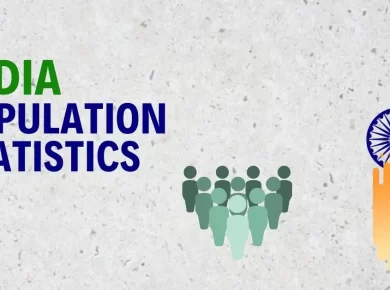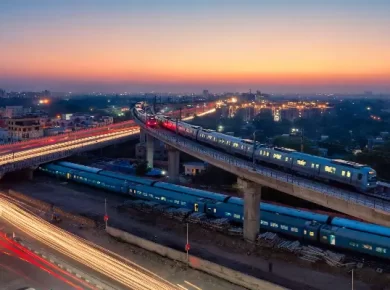Browsing Category
Indian Geography
Indian geography is vast and diverse, with varied landscapes, climates, and ecosystems. Located in South Asia, India is the seventh-largest country in the world by land area and the second-most populous. Its geography is influenced by its location in the northern hemisphere, bordered by the Himalayas to the north and surrounded by the Indian Ocean to the south.
Here’s an overview of India’s geography:
1. Physical Features of India
India’s physical geography is defined by several prominent regions, including the Himalayan mountain range, the Indo-Gangetic plains, the Thar Desert, the Deccan Plateau, and the coastal regions.
a) The Himalayas
The Himalayas are the northernmost mountain range and one of the most significant features of India’s geography. These towering mountains, which include some of the world’s highest peaks like Mount Everest, act as a barrier between India and the rest of Asia. They are also the source of many important rivers, such as the Ganga, Yamuna, and Brahmaputra.
b) The Indo-Gangetic Plains
The Indo-Gangetic Plains stretch across northern India, formed by the alluvial deposits of the rivers originating from the Himalayas. The Ganga and Yamuna rivers are crucial to this fertile plain, which is one of the most densely populated areas in India. This region is vital for agriculture and sustains a large part of the country’s population.
c) The Thar Desert
Located in the northwest, the Thar Desert is one of the largest deserts in India. It spans the states of Rajasthan, Punjab, and parts of Gujarat and Haryana. Despite its arid conditions, the desert supports human habitation and agriculture, especially with the use of irrigation.
d) The Deccan Plateau
The Deccan Plateau is a large region in southern India, bordered by the Western Ghats and Eastern Ghats. It is rich in minerals and is a major source of India’s coal, iron, and other resources. The plateau’s landscape is marked by flat terrain, hills, and valleys, with the Godavari, Krishna, and Kaveri rivers flowing through it.
e) Coastal Plains
India has an extensive coastline of about 7,500 kilometers. The Western Coastal Plain lies along the Arabian Sea, while the Eastern Coastal Plain borders the Bay of Bengal. The western coast has famous ports like Mumbai and Goa, while the eastern coast is known for ports like Chennai and Kolkata.
2. Rivers of India
India is blessed with numerous rivers, which are crucial for both agriculture and religious practices.
- Ganga River: The Ganga is the longest river in India and one of the holiest. It flows from the Himalayas through northern India and into Bangladesh.
- Yamuna River: A major tributary of the Ganga, the Yamuna flows through Delhi and Uttar Pradesh.
- Brahmaputra River: Flowing in the northeast, it enters India from China and continues into Bangladesh.
- Indus River: Originating in Tibet, the Indus flows through Pakistan, but its basin also affects parts of India, especially in Jammu and Kashmir.
- Godavari and Krishna Rivers: These are the major rivers of the Deccan Plateau that flow eastward and provide irrigation for crops in the southern region.
3. Climate of India
India experiences a variety of climates, ranging from tropical to temperate to alpine.
- Tropical Climate: Most of India experiences a tropical climate, characterized by hot summers, a monsoon season, and mild winters. The Western Ghats and coastal areas receive heavy rainfall during the monsoon.
- Desert Climate: The Thar Desert experiences a dry climate, with high temperatures during the summer and cold winters.
- Temperate Climate: The northern regions of India, particularly in the Himalayas, experience temperate conditions, with snowfall during the winter months.
- Monsoon Climate: India is heavily influenced by the southwest monsoon, which brings seasonal rainfall from June to September, vital for agriculture, especially in the central and northern regions.
4. Flora and Fauna
India has a rich diversity of flora and fauna, thanks to its varied climate and geography. The country is home to several biosphere reserves and national parks that protect its wildlife.
- Flora: India has a wide variety of vegetation, from tropical rainforests in the Western Ghats and Andaman Islands to temperate forests in the Himalayas. The Sundarbans in West Bengal is home to the world’s largest mangrove forest.
- Fauna: India is home to iconic species like the Bengal tiger, Indian elephant, one-horned rhinoceros, and Indian rhinoceros. The Indian peacock is India’s national bird, and there are numerous species of reptiles, amphibians, and marine life.
5. Regions of India
India is divided into several regions based on geography, climate, and culture:
- Northern India: Includes states like Jammu & Kashmir, Punjab, Haryana, Himachal Pradesh, and Uttarakhand, with the Himalayas as a prominent feature.
- Western India: Includes states like Rajasthan, Gujarat, and Maharashtra, known for deserts, the Thar Desert, and coastal regions.
- Southern India: Includes states like Tamil Nadu, Kerala, Karnataka, and Andhra Pradesh, featuring the Deccan Plateau, lush coastal plains, and the Western Ghats.
- Eastern India: Includes states like West Bengal, Odisha, and Bihar, with fertile plains of the Ganga, and coastal plains along the Bay of Bengal.
6. Major Cities
India has several important cities that are economic, political, and cultural hubs.
- New Delhi: The capital city, located in the north, is the political center of India.
- Mumbai: The financial capital, located on the western coast, is one of the largest cities in India and a global economic hub.
- Kolkata: Located on the eastern coast, it is a major cultural and intellectual center.
- Chennai: A prominent city in the south, known for its cultural heritage and as a hub for the automobile industry.
- Bengaluru (Bangalore): Known as the “Silicon Valley” of India, it is a tech industry hub located in southern India.
Conclusion
India’s geography is incredibly diverse, from the towering Himalayas in the north to the fertile Indo-Gangetic plains, from the vast Deccan Plateau in the south to the arid Thar Desert in the west. This variety not only shapes the climate and environment of the country but also influences its culture, economy, and history. India’s geographical features provide valuable resources for agriculture, industry, and tourism, making it a region of great global importance.







